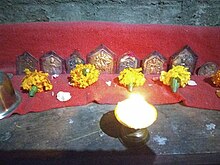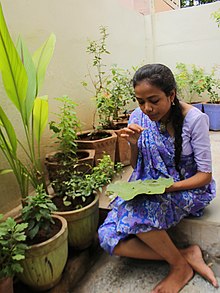Dhodia
| Dhodia | |
|---|---|
| Caste | |
| Location | Vapi To Tapi in Gujarat India |
| Population | 5,36,000 (2012) |
The majority of the Dhodia tribes are located in the southern part of Gujarat, Surat and Valsad districts, Dadra and Nagar Haveli and Daman and Diu, Madhya Pradesh, Maharashtra, Karnataka, Rajasthan of India. In Maharashtra, they are found mainly in the district of Thane.Their language is the Dhodia language. It is a language which is a mixture of unique words, as well as some words influenced by Gujarati as well as Marathi. Their language does not have a written tradition.[1][2]
History[]
There are many beliefs about the origin of the term "dhodia" [1]. One is that they came from a place called Dhulia. The other belief is that the Rajputs from around the Dholka Taluka, married local women in the tribal villages and later their descendants established themselves as Dhodia. However, these are all just folklore that have yet to be supported by scientific or historic data. The Naikda, another tribal community, claims common descent with the Dhodia.

Religion and customs[]
Most of the dhodia believe in traditional religious practices [2]. Dhodia primarily have adapted Hinduism. Some however follow Christianity. Some are following their Adiwashi traditions, worshiping nature. Dhodia also has many samaj within them.
Dhodia Females traditionally wear 'Kachhedo' or it called 'Dhadku' type of saree which mostly gives resembles of Marathi saree.


Festivals[]
They celebrate all the festivals that other Hindus do. Diwali, Holi are some examples. The majority of Dhodia believe in and are devoted to "Kanasari" or "Kanseri" (Goddess of food). They celebrate the "Kanseri" festival annually at harvest. The "Kanseri" Goddess is otherwise known as Goddess "Annapurna" by most Hindus.
The Dhodia also celebrate "Divaso".
Vagh baras is also celebrated in a unique fashion in some Dhodia villages where men colour themselves in stripes representing the Vagh( tiger) and others as plain white or other colours denoting cattle. The tiger chases the cattle. Finally at the end of the sport the village inhabitants eat together and celebrate. Also they make Bhakhras for pooja rituals to their Kuldev on this day.




See also[]
References[]
- ^ http://dhodia.info/language.aspx
- ^ People of India Maharshtra Volume XXX Part One edited by B.V Bhanu, B.R Bhatnagar, D.K Bose, V.S Kulkarni and J Sreenath pages 529-535
External links[]
- Dhodia Website
- Dhodia FaceBook Page
- Dhodia FaceBook Group
- Dhodia Community
- RDG
- Dhodia Matrimony
- Dhodia History
- Dhodia Language
- Dhodia Kul(કુળ)
- Dhodia Videos
- Dhodia Blog
- Dhodia Book 1:અહા આમું ઢોડિયા - શ્રી.કુલીન પટેલ
- Dhodia Book 2:ઢોડિયા જાતી: બોલી,સાહિત્ય અને સંસકૃતિ - સ્વ.શ્રી મંછારામભાઈ નારણદાસ પટેલ
- Dhodia Book 3:વડલો
- Social groups of Gujarat
- Social groups of Maharashtra
- Scheduled Tribes of Dadra and Nagar Haveli
- Tribal communities of Gujarat
- Tribal communities of Maharashtra
- Scheduled Tribes of Gujarat
- Scheduled Tribes of Daman and Diu
- Scheduled Tribes of Goa
